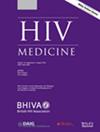Trends and disparities in antiretroviral therapy prescription rates among US Medicare beneficiaries with HIV
Abstract
Objective
Our objective was to evaluate antiretroviral therapy (ART) prescription rates over time among US Medicare enrolees with HIV and to describe disparities in ART prescription and associated factors.
Method
We constructed successive cross-sectional cohorts including adult enrollees with HIV and fee-for-service coverage and Part D enrolment in US Medicare between 2007 and 2019. We calculated the percentage of receipt of any ART prescription (ART%) in a calendar year by sex, age, and original Medicare entitlement and calculated age–sex standardized ART% over time. We used multivariable logistic regression to assess the association between ART prescription and sociodemographic factors and chronic conditions by age strata (<65, ≥65 years) in 2019.
Results
ART% increased over time and was highest among people with HIV aged 50–64 years in 2019: 95% in males and 92% in females. Multivariable analysis showed that female sex was associated with less ART%, with odds ratios (ORs) of 0.65 (95% confidence interval [CI] 0.60–0.70) and 0.34 (95% CI 0.30–0.39), than male sex in those aged <65 and ≥65 years, respectively. The youngest and oldest enrollees had lower ART use (e.g., OR 0.43 [95% CI 0.34–0.54] for 18–29 vs. 50–64 years; OR 0.34 [95% CI 0.30–0.39] for ≥80 vs. 65–69 years). The top conditions associated with less ART included dementia and alcohol use disorder. Other factors included no Part D low-income subsidy, non-Hispanic white race, and Midwest residence.
Conclusions
ART use increased over time in US Medicare enrollees. Non-Hispanic white, female, and the youngest and oldest enrollees received less ART. Multimorbidity, substance use, and dementia were associated with less ART use. Research to overcome these disparities is needed.

 求助内容:
求助内容: 应助结果提醒方式:
应助结果提醒方式:


